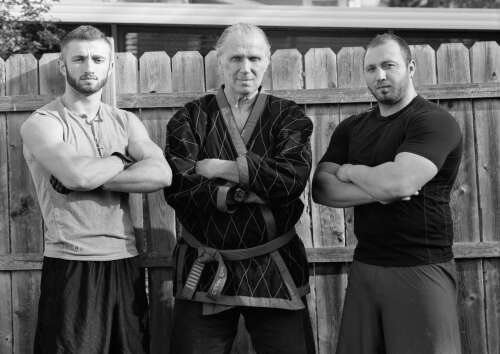Bob Beal (center), who was inducted into both the Illinois Boxing Hall of Fame and the Illinois Combat Sports Hall of Fame, passed away on May 27. Pictured here with his grandsons Dylan Edwards (left) and David Edwards.
Courtesy of Andre Avanesyan
If boxer and fighter Bob Beale hit you, you probably wouldn't get up.
Beal, who was once described as having “fists like the hammer of hell,” was inducted into the Illinois Boxing Hall of Fame and the Illinois Combat Sports Hall of Fame in 2015. He passed away on May 27.
Beale was a 1997 graduate of Chicago's Waller High School (now Lincoln Park High School) and lived in Des Plaines. He was 86 years old and had been married to his wife, Josephine (known as “Jo”), for 60 years.
“He left like a warrior,” said Dylan Edwards of Des Plaines, one of Beal's three grandsons.
He, too, lived the life of a warrior. Born Robert Brutus Beale, he was training in boxing by age 7 in the home-made gym of his stepfather, Frank Beale, and his father, Harold Lett. Known in the ring as Ray Vegas, Lett once fought Jack Dempsey to a draw in a bare-knuckle exhibition bout.
By age 13, Bob Beal began training in professional gyms under the tutelage of former world champions Johnny Coulon and Tony Zale, and went on to become a four-time Chicago Catholic Youth Organization heavyweight champion.
According to Beal's former martial arts student and studio partner, Fred Degerberg, Beal was a sparring partner for a young Cassius Clay at Coulon's gym.
According to BoxRec, Beal's amateur record is 291 wins and 9 losses.
In 1955, at the age of 17, Beal faced Pete Rademacher in a domestic heavyweight bout that also served as a qualifier for the 1956 Olympics. Beal knocked Rademacher out, but broke Rademacher's hand in the process, and Rademacher advanced to the Melbourne Olympics, where he won the gold medal.
Beale's power caused repeated hand injuries and he retired from boxing in the late 1950s, and former undefeated heavyweight champion Rocky Marciano was unhappy when he approached Chicago to become Beale's manager, Degerberg said.
Beale first turned to wrestling and then martial arts, achieving grandmaster status and a 10th-degree black belt in Bushido Karate.
Bushido, or “the way of the samurai,” is a combination of boxing, wrestling, karate and various martial arts that Beal developed with the help of fellow grandmaster Degerberg, a 10th degree black belt.
Beal and Degerberg met at former Marine Ted Amos' Byakko-Do Karate-Kai studio in the early 1960s and went on to found Midwestern Bushido, the precursor to today's mixed martial arts.
“He was one of the first mixed martial artists in the 1960s and '70s,” Dylan Edwards said.
Beal later took over Amos' studio and renamed it “Bushido Fighting Society.” Beal operated studios in several different locations in Chicago throughout his career.
Beale awarded his first black belt to Degerberg, who opened the Degerberg Martial Arts Academy in 1980.
“He was a fine man,” Degerberg said.
“He didn't say much because he couldn't hear very well. He was a 'actions speak louder than words' type of guy. And he was a really nice guy,” Degerberg said.
Beal retired from professional training in 1997. At home, he was an accomplished woodworker and loved classic horror movies, watching the Green Bay Packers and the Minnesota Vikings.
Bob and Josephine Beale had two children, Cora and Jean, three grandsons, Michael, David and Dylan, and one great-grandson, Colton.
“He was like a father to me and my brothers and I was one of his last students,” said Edwards, who earned his black belt under Beal and Degerberg.
A ceremony celebrating Beale's life will be held at Degerberg Martial Arts Academy, 4717 N. Lincoln Ave. in Chicago, on July 27 from 5 to 10 p.m.

